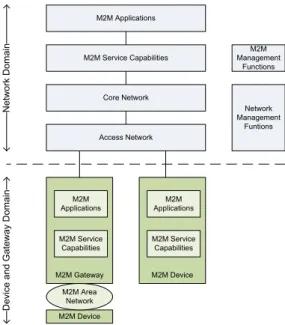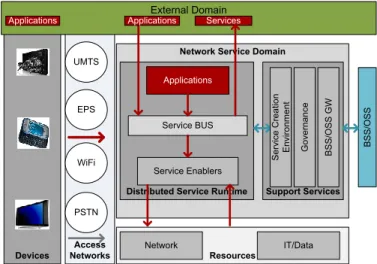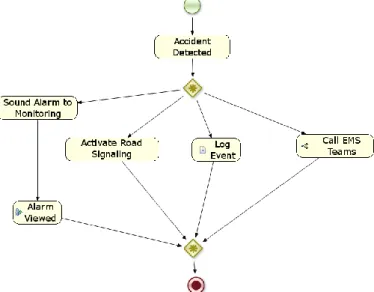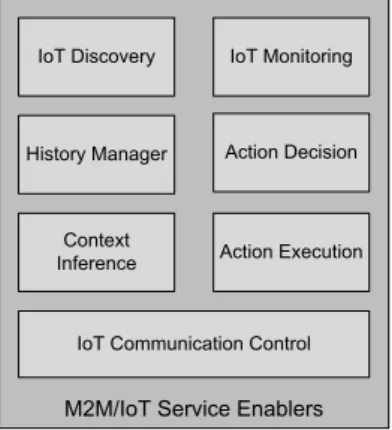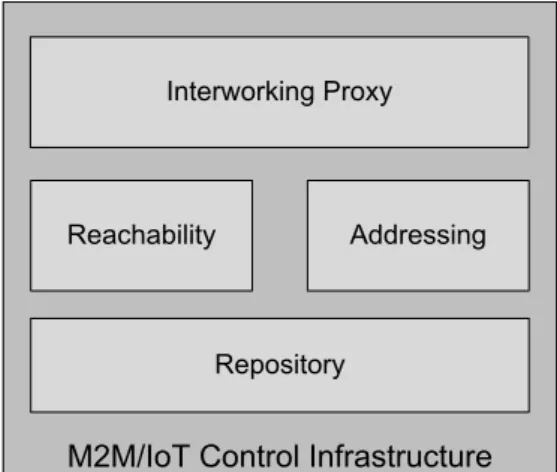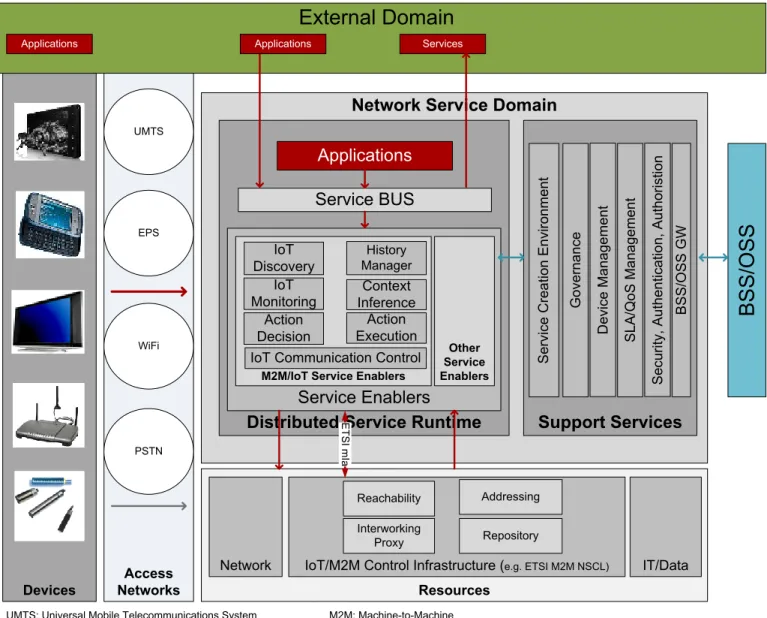An Architecture for the Future Business of Things
F. Cabral Pinto, P. Chainho, N. Pássaro, F. Santiago
PT Inovação, PTIN Aveiro, Portugal
D. Corujo, D. Gomes
Instituto de Telecomunicações, Universidade de Aveiro Aveiro, Portugal Abstract— A brave new world made of interconnected smartdevices will soon revolutionize the world. The application of the Internet of Things vision will foster the creation of new businesses across different industrial sectors. Communication Service Providers need to set the pace of this change if they want to lead this transformation. They need to both leverage and evolve their architectures in order to support a flexible creation of innovative services over distributed networks, linking heterogeneous sensors and actuators. This paper presents the roles of the telecoms on the upcoming machine-to-machine markets and devises an advanced architecture able to withstand the demands of a new plethora of evermore clever and useful services.
Keywords: Architectures; Business of Things; Communication Service Providers; Internet of Things; Machine-to-Machine; Sensors; Service Delivery Framework.
I. INTRODUCTION
Advances in electronics miniaturization, coupled with the development of novel networking protocols taking advantage of different kinds of access networks, have triggered the massive spread of devices with communication capabilities realizing the Internet of Things (IoT) vision. Here, different kinds of interlinked devices can provide information about the environment where they are installed, as well as being able to receive control requests from intelligent frameworks. These frameworks leverage this connectivity to optimize existing industrial, telecommunication, commercial and personal processes, reducing the gap between the digital and the physical world.
There is an ongoing revolution supported by linked machines able to communicate without human intervention, providing the most varied sort of information allowing the provisioning of personalized contents and experiences to a growing number of demanding customers. However, the heterogeneous environments provided by the different kinds of access network technologies, the disparate requirements and capabilities of the devices and the distinct application scenarios place stringent requirements in terms of technological interfacing and interaction. As such, standardization and integration efforts need to be set in place, facilitating the adoption of IoT solutions and leveraging existing control, management and security procedures.
Parallel to this, the advent of machine-to-machine (M2M) communications opens the doors to a new world of innovative business. M2M embraces a broad field of action across several
industrial areas, such as health, agriculture, security, facility management, retail, automotive or personalization. Communication Service Providers (CSP) need to set the pace of this change if they want to lead the transformation of this new market. They need to become key players in the M2M ecosystem by facilitating the creation of new businesses regardless of field of action. For that, CSP must evolve their systems in order to support fast service creation, able to run over distributed networks, facilitating seamless connections of heterogeneous sensors and actuators while assuring the compatibility with the main standards.
This is where this paper contributes by proposing a service-oriented architecture capable of supporting the construction of a new generation of M2M applications within different sectors of activity, ensuring the realization of a wide range of new businesses, and leveraging current M2M standardization efforts.
The remainder of this paper is structured as follows. Section II provides the motivation for the proposed architecture, by introducing the concept of Business of Things, as well as providing a Service Scenario and presenting related work. Section III elaborates on the proposed architecture, focusing on the provisioning of a Service Creation Environment and on the realization of the Service Delivery concepts within M2M environments. Finally, Section IV concludes the paper.
II. MOTIVATION
This section describes the key motives for CSP addressing M2M as an opportunity to leverage their existing frameworks, presenting a specific scenario example and providing a state-of-the-art in technological solutions of this area.
A. Business of Things
A new world of things will trigger the creation of an unlimited set of innovative businesses, where the information and control allowed by interlinked devices will provide enhanced capabilities. The business of things generates a new set of opportunities that CSP cannot lose; they shall take the following roles in order to become key stakeholders on this huge market:
Connectivity Management – CSP must ensure the
transmission of M2M information in a transparent way between end-points, while ensuring specific quality of service and security characteristics of the communication channel. In
these cases, operators are just traditional bit pipes for data flow without any type of data intervention, leveraging their already existing access networks towards an increased amount of connected devices.
Data Management – The sheer amount of new devices will
ultimately generate large amounts of data (Big Data) that requires storage and/or processing. The characteristics of such information require that its storage and processing must be distributed. Due to the nature of their networks, CSP are the most qualified entity to handle this issue. They can make the bridge between applications and heterogeneous devices, allowing a fast service creation. However, the M2M information is still opaque for CSP although they must ensure a reliable management of the data.
Service Provisioning – CSP can create their own services
making them available to end-users or to other applications (e.g., third party products), which now are enriched with access to device information and control, deployed in a large variety of scenarios. In this situation, operators are still responsible for data transmission and management. Furthermore they use the data made available by devices to provide value added information towards interested entities, which can now enhance their processes with new features and functionalities.
Figure 1 presents the operators’ roles in the M2M ecosystem. Communication Service Providers M2M Connectivity Management M2M Data Management M2M Service Provisioning
Figure 1 - Roles of Communication Service Providers
B. Service Scenario
The following section illustrates a scenario exemplifying a telecom-assisted M2M service deployment.
Bob was always in a hurry. He was always late and never found a place to park the car. In order to improve his lifestyle, he is now a volunteer in a program launched by the city hall to improve the road conditions and to ensure a safe driving. In return for his help, he gets a free access to the available car parks in the city centre. Bob uses his mobile phone to capture very useful information. The sensors integrated in his terminal, like GPS, accelerometer or gyroscope, are used to detect sudden braking, very tight turns, areas of congestion, or even holes in the street. Furthermore, using a specific speech tool, it detects that people honking heavily, car collision, and even the stress in Bob’s voice. All this information, combined with the one received from the other volunteers, is analysed in real-time
by a central application. As a consequence, Bob’s mobile phone presents all relevant information about road conditions, which helps him to avoid traffic jams. He is therefore advised about the best way to reach a specific place making his life much easier. Moreover, road signalling is also set to inform all drivers about congestion points on the streets. Additionally, the collected data also allows emergency services to become automatically aware about the occurrence of collisions, improving their response time, making it possible to save thousands of lives. Finally, the city hall experts can use the roads usage information to derive and then correct the main black spots of the streets in order to ensure a safer road network.
C. Related Work 1) Standards
The European Telecommunications Standards Institute (ETSI) is pushing for M2M standardization in order to foster the creation of profitable solutions, quickly launched in a global market. It has recently concluded the first release of its M2M standards where the functional architecture is defined [1]. The high level architecture for M2M, as presented in Figure 2, encompasses two independent domains: the network domain, and the device and gateway domain.
M2M Applications Access Network Core Network M2M Service Capabilities Network Management Funtions M2M Management Functions N et w or k D om ai n D ev ic e an d G at ew ay D om ai n M2M Gateway M2M Applications M2M Service Capabilities M2M Device M2M Applications M2M Service Capabilities M2M Device M2M Area Network
Figure 2- High level architecture for M2M [1]
The network domain consists of several elements, namely: M2M applications, M2M service capabilities, M2M core network and access network. The M2M applications run the service logic allowing the creation of value for users or machines. The M2M service capabilities make available a set of functions exposed by open interfaces, to be shared among different applications, enabling fast service creation. IP connectivity is supported by the core network, which ensures network interconnectivity over various technologies. Finally, the access network links the devices and gateways with the core network. The network domain still encompasses the network and the M2M management functions, which include
all the functionalities required to manage the access, core network and the M2M service capabilities.
The device and gateway domain includes the devices, the gateways and the M2M area network. The devices run M2M applications supported by service capabilities. The gateways, besides running M2M applications using the service capabilities, act as a proxy between the devices and the network domain. The M2M area network enables the connectivity between devices and gateways.
2) Service Delivery Framework
The CSP are currently facing big challenges from Over-the-Top (OTT) players like Google, Skype and Facebook. These emerging players are disrupting the market by providing new services supported on innovative business models that are eroding CSP revenues. To overcome such challenges, and to become more agile, CSP are starting to embrace new service delivery paradigms based on Service-Oriented architectural principles: the Service Delivery Framework (SDF).
The SDF is a layered architecture designed to enable rapid, cost-efficient service creation, deployment, execution, orchestration and service management. It provides common service execution environments, data repositories and a suite of standardized service enablers to be shared by services and applications. SDF can be seen as an adaptation of the Service-Oriented Architecture (SOA) to the telecommunications world. A generic SDF is represented in Figure 3.
Service capabilities provided by service enablers are consumed through APIs published in the Service BUS. The Service BUS provides middleware enterprise service functionalities, i.e., it mediates all interactions between the service enablers and consumers, featuring all needed abstraction characteristics to support loose coupling dependencies among services. Service enablers encapsulates different types of resources including network resources (such as IMS Core, SMS Centres, etc.), operation and business support resources (e.g. Online Charging Systems) and resources that are outside CSP domain, such as 3rd party gateways (e.g. Facebook Connect). Applications featuring user interfaces consume service enablers functionalities via the Service BUS. The SDF provides their own management functionalities set – service delivery support services (SDSS) – which are mainly used to enforce a consistent and harmonious governance of SDF services’ life-cycle, including conception, design, deployment, operation and removal. SDSS services are also providing interoperability with business and operation support systems (BSS/OSS) reusing as much as possible existing functionalities.
Access Networks Devices
Network Service Domain
Distributed Service Runtime
Resources Network External Domain IT/Data Applications Service Enablers Service BUS Support Services G ov er na nc e B S S /O S S G W B S S /O S S
Applications Applications Services
UMTS WiFi EPS PSTN S er vi ce C re at io n E nv iro nm en t
UMTS: Universal Mobile Telecommunications System EPS: Evolved Packet System
PSTN: Public Switched Telephone Network BSS/OSS: Business and Operation Support Systems
Figure 3 - Service Delivery Framework
3) Research Community
Research efforts have been focusing on progressing M2M application engineering by moving typical framework deployments from vertical (e.g., silos) to a horizontal approach. In this way, the different layers involved in a M2M system (e.g., application domain, network domain and M2M devices domain) can still interact independently of how each one is instantiated. However, due to the heterogeneous nature of each layer, different solutions for integrating devices and applications have been generated, ranging from multi-device middleware interfacing, to Web-Based device access and telecom operator architecture integration.
Contributing towards this view, the authors in [2] and [3] explore Web Services-based middleware for wireless sensors, focusing on Simple Object Access Protocol (SOAP), allowing a course grained, loose coupled and synchronous access to sensors, by applications. Other approaches [4] consider the usage of RESTFul (REpresentational State Transfer) Web Services, for Resource-Oriented access to devices, taking advantage of underlying lightweight web mechanisms. However, the deployment of web-based approaches can be complex in constrained environments, where devices with reduced capabilities (e.g., memory and processing) might not be able to encompass a full web stack. This motivated the development of resource conservation approaches, such as the IETF Constrained Application Protocol (CoAP) [5] at the network layer [6]. Other solutions provide a cross-layer interaction [7] that exploits a media independent interfacing, optimizing device control and information obtaining, in both constrained and richer environments. Layering approaches for device access have also been explored in CSP architectures, using the IP Multimedia Subsystem (IMS) [8][9], or the Evolved Packet Core (EPC) [10]. These allow the integration of the control and management infrastructure of the operator to assist and leverage M2M communications, providing them as a service using their access network. Finally, other approaches aiming to empower the small capacity of devices with enhanced processing and possibilities towards rich applications
have provided M2M integration solutions considering virtualization [11] and Cloud Computing [12].
Some efforts have been carried out to define an IoT-based architecture. The Physical with the Digital World of the Network of the Future (SENSEI) project aimed at designing a global and pluggable framework for wireless sensor and actuator networks [13]. It made available the necessary network and information management services in order to enable a consistent context information retrieval and interaction with the physical environment [14]. The SENSEI project was, however, mainly focused on enabling the interactions with the physical world, being its main efforts in the resource layer. Additionally, the SOA4ALL project proposed a domain independent service delivery platform realizing a world where services and data are exposed through advanced Web technology [15][16]. It makes use of semantic web technologies to improve service description and facilitate its discovery. SOA4ALL employs context management mechanisms to customize the existing services for the user needs. However, the SOA4ALL architecture did not focus on IoT domain letting aside its main characteristics and constrains. Finally, the IoT-A project focuses its research in the provisioning of interoperability at communication, service and knowledge levels across different platforms [17]. It proposes a reference architecture which aims to achieve a common foundation for the design of IoT systems’ protocols, interfaces and algorithms [18]. The IoT-A reference architecture provides a set of strategies useful for the definition of IoT systems, however, it does not instantiate a specific architecture.
As can be seen, different solutions allowing the integration between M2M devices and applications exist, each targeting its own specific deployments. This variety, although pushing the evolution in the M2M area, creates a mixed environment that hinders interoperable solutions. As such, a common standards-oriented approach that is flexible enough for integrating different devices into an application-rich environment is needed.
III. PROPOSED ARCHITECTURE
CSP need to evolve their systems to take part of this brave world where connected objects will trigger innovative services. The advent of M2M communications introduces the need for a great level of flexibility in the service life-cycle management, from the service creation until the service runtime. The proposed architecture is focused on the service layer and is based on SOA and SDF principles being agnostic of IoT infrastructure implementation. SDF architecture is leveraged by introducing a set of IoT enablers that encapsulates the IoT infrastructure bridging the gap between the physical and digital worlds. Furthermore, SDF support services have to address some IoT challenges, namely the management of constraint and large scale distributed runtime environments. The following subsection presents the mindset towards an architecture where operators can have a key role on future business of things.
A. Service Creation Environment
The Service Creation Environment (SCE) concept is to allow the fast creation of services through the usage of a tool that implements standard technologies, able to interact with heterogeneous environments, thus reducing the time-to-market of applications.
The SCE must allow both technical and business oriented professionals to develop services for an emerging business need in the shortest time possible. In order to achieve this, an SCE must not only provide a graphical user interface (GUI) that is highly usable and flexible, but must also implement a set of processes, that are referenced as Governance [19], to guide all the necessary steps for the design, development, test and deployment of the necessary services.
This section will be focused on service composition as the strategy to achieve the SCE objectives. Service composition can be realized through process/workflow and rules definition.
The most widely used process/workflow representation languages in the industry are Business Process Execution Language (BPEL) [20] and Business Process Modelling Notation (BPMN) [21]. Both languages focus on specifying an operation flow that responds to events. However, it should be noted that BPMN is much more than a mere definition of a software process; it is a standard notation to represent organizational processes. Nevertheless, this notation is flexible enough to describe software processes at the same level as BPEL. Services composed of other atomic services are created through the usage of engines (e.g. jBPM5) able to interpret BPEL and BPMN when represented in XML format.
One of the most important aspects of a SCE, based on these standards, is the possibility to represent services in a standard visual language, as described in Figure 4. This intends to allow not only developers to create a new service but to let domain experts to easily respond to a business opportunity through the usage of the SCE visual service edition interface.
Figure 4 - Example SCE workflow
To allow this, the proposed SCE provides the domain expert with visual representations of all services and
components deployed and/or accessible by the M2M platform. Being compliant with industry standards for process workflow representation, it is expected to reduce the necessity of extensive training to work with the platform.
In addition, the proposed approach has the advantage to fully decouple the service execution environment from the service creation environment. As such, it becomes possible to reduce the impact of adding new service execution environments to the solution.
Regarding the IoT, atomic services that are developed and exposed in the M2M platform can then be orchestrated to correspond to a business need. The example presented in Figure 4 shows a simple composite service to detect accidents on a road. It is composed of several component services (including a composite service and a human action): Accident
detected. Accident detected gathers data from drivers mobile
phones - once that service detects a determinate pattern of data from the sensors, it triggers other atomic services shown in the flow; Sound alarm to monitoring and alarm viewed allow to warn the road monitoring team and guarantee, from the human action Alarm Viewed, that the alarm was actually seen by a human; Activate Road Signalling signals other drivers of danger; “Log Event”, logs the occurrence for posterior analysis; “Call Emergency Team” is another composite service, invoked by the composition, used to call the emergency teams required to help in the accident area.
The example in Figure 4 illustrates how the SCE is able to add value to the M2M ecosystem. It opens the IoT to the more business focused professionals by allowing the management of services in a comprehensible format, reducing the time to market of new services and letting its integration in different environments through the usage of standards.
B. Service runtime
The innovative services introduced by M2M communications require a flexible architecture that supports the interconnection of heterogeneous devices, using different access technologies, running in distributed environments, abstracted by loose coupled enablers possibly owned by different providers. M2M communications are therefore a great candidate to be redesigned in a Service-Oriented Architecture approach.
1) Devices
The advances in electronics miniaturization have contributed to the coupling of wireless communication abilities to different kinds of physical devices, such as sensors (e.g., accelerometer and oscilloscope) and actuator components (e.g., adjustable cameras or robotic arms). This large set of new machines with communication capabilities will populate the landscape of the traditional devices, making possible to enrich the scope of the SOA-based services.
2) Service Enablers
The proposed architecture relies on a set of M2M/IoT service enablers, with the purpose of both facilitating as well as leveraging the access to the devices. In order to support such operations, the service enablers come coupled with a set of assisting mechanisms as described next.
In order to expose the M2M services to interested entities, the IoT Discovery component provides a complete description of the interfacing capabilities of the service enabler, identifying the necessary access and interfacing procedures. Therefore, the IoT Discovery provides the way to join service providers and consumers in a regular way.
It is essential to have mechanisms to deal with M2M data storage. The History Manager enabler uses specific policies to control the archive of relevant information. It interacts with the entities involved in the data exchange to gather the M2M information.
The IoT Monitoring entity enables the monitoring of M2M data streams in order to detect the occurrence of specific events. The monitoring is done at IoT resource level to protect the Service BUS of the massive information exchanged between M2M applications.
The Context Inference component analyses and applies meaning to the raw sensor data, in an extensive way, inferring high-level context information to end-users. To cope with the needs of a wide range of entities, the context inference enabler allows the employment of different reasoning mechanisms to derive useful and refined information.
The Action Decision component processes in real-time the information received from different parts of the system (e.g., IoT Monitoring), using it to act upon the service logic with the aim of maintaining and optimizing its flow. These actions are enforced by the Action Execution component, which performs the requested functionalities.
Finally, the Communication Control encompasses all the functionalities related with the management of the communication between devices and service platforms. It controls the establishment, modification and release of the transport channels, being responsible for enforcing the data cyphering and integration. It allows the request/response and the publish/subscribe message exchange patterns. Moreover, it ensures the atomicity in the execution of transactions between several entities. This enabler is still responsible for the communication selection when the devices are skilled to communicate using more than one radio access technology.
Figure 5 presents the new Service Enablers required to support the M2M/IoT services.
M2M/IoT Service Enablers
History Manager IoT Monitoring Context Inference Action Decision Action Execution
IoT Communication Control IoT Discovery
3) M2M/IoT Control Infrastructure
The engagement of machine-to-machine communications with the SDF architecture mandates the control of specific M2M/IoT infrastructure. Following are described the required functionalities.
The Interworking Proxy functionality is core to ensure the link between devices or gateways compliant with different specifications. The interoperability capabilities are deep dependent on the characteristics of the M2M devices and gateways.
The Reachability element is used to notify the service capability layer in the network side about the availability status and the scheduling reachability of devices and gateways.
The Addressing entity controls the network addresses of M2M devices and gateways. It is responsible for managing the multiple addresses they can have in order to make them reachable.
The M2M information requires specific elements for real-time data storage. The Repository provides the mean to save volatile information exchanged between M2M service capability layers. It makes it available on request or based on subscriptions to authorized consumers.
The M2M/IoT control functionalities are presented in Figure 6.
M2M/IoT Control Infrastructure
Reachability Addressing
Repository Interworking Proxy
Figure 6 - M2M/IoT Control Infrastructure
4) Support Services
The support services enforce a reliable governance of SDF services life cycle. A set of new functionalities arises to enable the introduction of M2M/IoT services in a SOA.
The SLA/QoS Management entity provides the required functionalities to ensure the compliance of the commitments undertaken by the CSP with their customers and consumers. When needed, it performs changes in the conditions of M2M service delivery, such as providing a greater allocation of resources or limiting the functionality of the services delivered.
The Monitoring and Adaptation functionality is responsible for central monitoring of M2M services over the distributed systems, ensuring the SLA accomplishment. It allows service
adaptation in response to contextual changes, which can lead to the reselection of involved components.
The Device Management entity provides configuration-controlling utilities. It allows the management of heterogeneous M2M devices and gateways. It is responsible for the M2M devices and gateways lifecycle management by facilitating the installation, removal and upgrade of devices’ functionalities. Additionally, it allows the configuration of the M2M service capabilities in the M2M devices and gateways.
The Security, Authentication and Authorisation entity deals with the security related issues. It performs the access right management of M2M resources. It also implements mutual authentication and key agreement. Moreover, it supports key hierarchy realisation for authentication and authorization.
Finally, the Governance support service manages the access control to the system, affecting all its lifecycle. It employs user roles to differentiate the levels of access to the system functionalities.
Figure 7 shows the M2M/IoT Support Services.
M2M/IoT Support Services
Device Management Security, Authentication, Authorisation Governance SLA/QoS Management Monitoring and Adaptation
Figure 7 - M2M/IoT Support Services
C. Architecture
The realization of Internet of Things requires the existence of devices with communication capabilities in an Internet-like way. These devices can be used to sense and to actuate on physical entities enabling the creation of useful services. For that, a set of M2M service enablers need to be designed and developed in order to encapsulate the network resources allowing applications to access sensors and actuators in a seamless way.
Figure 8 presents the proposed M2M-oriented architecture designed to give support to the new set of business of things. It encompasses the described support services, service enablers and related resources. It applies the Service-Oriented Architecture concepts to the M2M communication providing the required flexibility to the creation of new services while ensuring the compatibility with the main standards, such as ETSI [22], 3GPP [23], OASIS [24] or Open Group [25].
Access Networks Devices
Network Service Domain
Distributed Service Runtime
Resources Network
External Domain
IT/DataApplications
Service Enablers
Service BUS
Support Services
G ov er na nc e B S S /O S S G WB
S
S
/O
S
S
Applications Applications Services
UMTS
WiFi EPS
PSTN
IoT/M2M Control Infrastructure (e.g. ETSI M2M NSCL)
M2M/IoT Service Enablers
Other Service Enablers S er vi ce C re at io n E nv iro nm en t D ev ic e M an ag em en t S LA /Q oS M an ag em en t S ec ur ity , A ut he nt ic at io n, A ut ho ris tio n History Manager IoT
Monitoring InferenceContext Action
Decision
Action Execution IoT Communication Control
IoT Discovery Reachability Addressing Repository Interworking Proxy E T S I m Ia
UMTS: Universal Mobile Telecommunications System M2M: Machine-to-Machine
EPS: Evolved Packet System IoT: Internet of Things
PSTN: Public Switched Telephone Network NSCL: Network Service Capability Layer
BSS/OSS: Business and Operation Support Systems
Figure 8 - M2M in a Service Delivery Framework IV. CONCLUSION AND FUTURE WORK
We are now facing a remarkable progress where communicating machines will trigger the foundation of a new world of services. Communication service providers must be part of this revolution by enabling the creation of novel business across different industrial sectors. They can provide the communication channels, manage the M2M information or even deliver their own services. For that, CSP need to evolve their networks to support the great dynamics of M2M communications.
A Service Delivery Framework is a paradigm that aims to facilitate the development and maintenance of new business processes supported on large, heterogeneous and distributed systems. The advent of M2M communications forces SDF to evolve in order to support the upcoming market.
This paper proposes a SDF architecture skilled to hold out to the demands of a new plethora of valuable services. It takes into account all M2M service lifecycle and devises the main functionalities in both service creation and runtime environments. It ensures the realization of a wide range of new business of things and simultaneously enforces the current M2M standardization efforts.
As a future work it is envisaged the implementation of the main functionalities in a testbed in order to proof the concepts here proposed. Furthermore, it is expected a performance evaluation, which can serve as a base for the comparison with other IoT systems.
ACKNOWLEDGMENT
This work is partially supported by the European ICT project “IoT.est” - Internet of Things Environment for Service Creation and Testing - (ID: 288385) [26]
REFERENCES
[1] ETSI TS 102 690 V1.1.1, “Technical Specification Machine-to-Machine communications (M2M); Functional architecture”, October 2011 [2] N. Othman, R. Glitho, F. Khendek, “The Design and Implementation of
a Web Service Framework for Individual Nodes in SInkless Wireless Sensor Networks”, Proceedings of IEEE Symposium on Computers and Communications (ISCC’07), Aveiro, Portugal, July 2007
[3] T. Ta, N. Othman, R. Glitho, F. Khendek, “Using Web Services for Bridging End-User Applications and Wireless Sensor Networks”, Proceedings of IEEE Symposium on Computers and Communications (ISCC’06), Sardinia, Italy, June 2006
[4] Z. Shelby. 2010. “Embedded web services”, Wireless Communications, 17, 6, December 2010
[5] Z. Shelby, K. Hartke, B. Frank, “Constrained Application Protocol (CoAP)”, Internet-Draft, IETF, March 2012
[6] W. Colitti, K. Steenhaut and N. DeCaro, “Integrating Wireless Sensor Networks with the Web”, Extending the Internet to Low Power and Lossy Networks (IP+SN 2011), Chicago, April 2011
[7] D. Corujo, M. Lebre, D. Gomes, R. L. Aguiar, “MINDiT: A Framework for Media Independent Access to Things”, Elsevier Computer Communications, Special Issue on on Smart and Interactive Ubiquitous Multimedia Services, Mar 2012
[8] M. El Barachi, A. Kadiwal, R. Glitho, F. Khendek, R. Dssouli,. The Design and Implementation of Architectural Components for the Integration of IP Multimedia Subsystem and Wireless Sensors Networks, IEEE Communications Magazine, 48, No4, 42 – 50, April 2010
[9] F. Cabral Pinto, N. Carapeto, A. Videira, T. Frazão, M. Homem, “Context-aware Multimedia Distribution to Mobile Social Communities”, International Journal of Handheld Computing Research (IJHCR), 2012
[10] M. Corici, J. Fiedler, T. Magedanz, D. Vingarzan, "Evolution of the resource reservation mechanisms for machine type communication over
mobile broadband Evolved Packet Core architecture", GLOBECOM Workshops (GC Wkshps), December 2011
[11] A. Bhattacharya, M. S. Fernando, P. Dasgupta, “Community sensor grids: virtualization for sharing across domains”, In Proceedings of the First Workshop on Virtualization in Mobile Computing (MobiVirt '08). Breckenridge, CO, USA, 2008.
[12] C. Doukas, I. Maglogiannis, "Managing Wearable Sensor Data through Cloud Computing," Cloud Computing Technology and Science (CloudCom), 2011 IEEE Third International Conference on, Nov. 29 2011-Dec. 1 2011
[13] http://www.sensei-project.eu/
[14] SENSEI, Deliverable D3.2, “Reference Architecture”, January 2009 [15] http://www.soa4all.eu
[16] SOA4All, Deliverable D1.4.1A, “SOA4All Reference Architecture Specification”, March 2009
[17] http://www.iot-a.eu/
[18] IoT-A, Deliverable D1.3, “Architectural Reference Model for the IoT (updated)”, July 2012
[19] J. Falkl; Phil Fritz; Maryann Hond, “Realizing business flexibility through integrated SOA policy management.” SOA Police Management
White Paper at IBM, April 2009
[20] OASIS, “Web Services Business Process Execution Language”, version 2.0, 11 April 2007
[21] OMG, “Business Process Model and Notation”, version 2.0, January 2011 [22] http://www.etsi.org/ [23] http://www.3gpp.org/ [24] https://www.oasis-open.org/ [25] http://www.opengroup.org/ [26] http://ict-iotest.eu/
